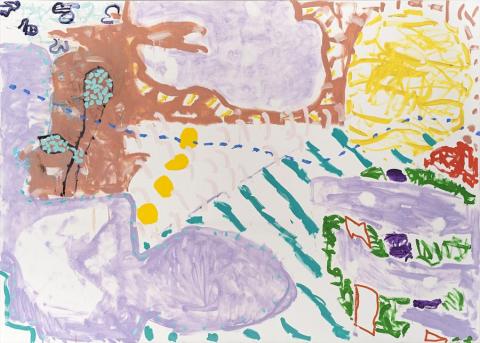SYDNEY GARDEN PAINTING: DECEMBER 1989 I, 1989
PATRICK HERON
oil on canvas
152.0 x 213.5 cm
signed, inscribed and dated verso: PATRICK HERON / SYDNEY GARDEN / PAINTING: DEC / 1989: I
Rex Irwin Art Dealer, Sydney
Private collection, Sydney (acquired from the above in 1990)
Patrick Heron, Rex Irwin Art Dealer, Sydney, 9 – 28 April 1990
Sydney : November 15 : 1989, 1989, gouache, 58.0 x 76.0 cm, Collection of the Art Gallery of New South Wales, Sydney
Sydney : 7 February : 1990: I, 1990, gouache, 58.0 x 77.0 cm, Collection of the Art Gallery of New South Wales, Sydney
Sydney: 27 February 1990, 1990, gouache, 45.5 x 63.2 cm, Collection of the Art Gallery of New South Wales, Sydney
Born in Leeds in 1920 into a family of clothing designers and manufacturers, at 17 years of age Patrick Heron studied at the Slade School of Art in London. From his early exposure to work by Cézanne, Matisse, Bonnard and Braque, in the 1950s his work was further influenced by the emergence American Abstraction. During the 1960s, Heron was at the vanguard of English non-figurative painting and his essays and lectures on form and colour were landmark treatises on abstraction.
After a long association holidaying and working in St Ives, Cornwall, where he formed long-standing friendships with artists Ben Nicholson, Barbara Hepworth and other painters of the St Ives School, in 1956 he moved his family permanently to Zennor, Cornwall, creating his wild garden at his home, Eagles Nest, overlooking the sea.
'Heron's Garden Paintings of 1956 mark a singular achievement within British Art of the period. With these canvases Heron found a route towards abstraction, not of a given motif, but instead formed from the formal balance achieved between the visual reality of what he saw in the garden at Eagles Nest and the pictorial reality of what he painted.'1
He exhibited extensively in England and America, and held two exhibitions in Sydney at Bonython Galleries in 1967 and 1973, delivering the 1973 John Power Lecture in Contemporary Art in which he stated, 'There is no shape that is not conveyed to you by colour, and there is no colour that can present itself to you without involving shape.'2
For five months from late 1989 Patrick Heron was artist in residence at the Art Gallery of New South Wales, Sydney. Sponsored by Lord McAlpine, his day started with a walk through the Royal Botanic Gardens to the AGNSW, from where he could look out to the harbour. He completed six large paintings and forty-six small gouaches. The works completed during this residency were exhibited at Rex Irwin Art Dealer, Sydney in 1990, and the remaining works were later shown in London.
He was utterly entranced by the natural beauty of Sydney Harbour and Pittwater, a series of small gouaches of West Head in particular vibrate with the intensity of colour of the Sydney summer. Late jacaranda and wattle shine against the drab and dark greens of the headlands. Part aerial in view, Woolloomooloo Bay and the Botanic Gardens appear in the lower left. Forms read as cacti may also be boats moored in bays. Swathes of terracotta roofs run down the ridges towards the water.
The rocky outcrops of Sydney in bushland and harbour-side gardens reminded him of his own garden in Cornwall, where exotic bushes grew in the lee of large boulders, against the backdrop of the sea. In Sydney his work became less dense, the whiteness of the background became as important as the calligraphic marks of pure colour on the surface, but still his language of shapes is there, the squares and spheres from the 70s paintings. They were a logical development of the garden paintings he had been painting since 1956. In Heron's own words 'The colour of colours and the shape of shapes are mutually definitive... and are forever changing.'3
Heron died at his home in Cornwall in 1999 at the age of 79.
1. Wilson, A., Patrick Heron, Early and Late Garden Paintings, Tate Publishing, London, 2001, p. 10
2. McNay, M., Patrick Heron, St Ives Artists, Tate Publishing, London, 2002
3. Heron, P., The Colour of Colour, E. William Doty Lectures in Fine Arts, College of Fine Arts, University of Texas at Austin, 1978, p. 59
